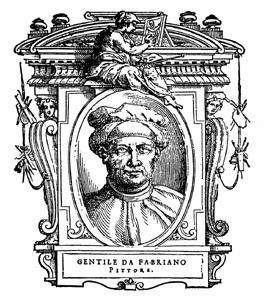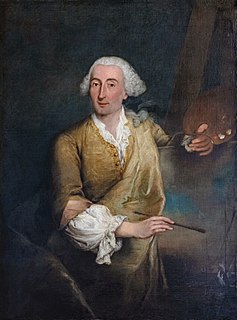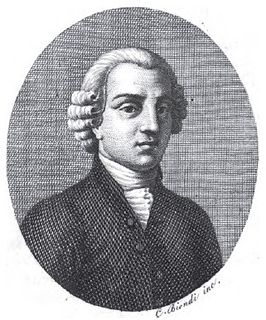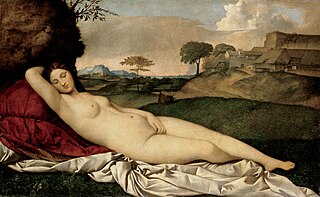
Giorgio Vasari was an Italian painter, architect, engineer, writer, and historian, best known for his Lives of the Most Excellent Painters, Sculptors, and Architects, considered the ideological foundation of art-historical writing, and the basis for biographies of several Renaissance artists, including Leonardo da Vinci. Vasari designed the Tomb of Michelangelo in the Basilica of Santa Croce, Florence that was completed in 1578. Based on Vasari's text in print about Giotto's new manner of painting as a rinascita (rebirth), author Jules Michelet in his Histoire de France (1835) suggested adoption of Vasari's concept, using the term Renaissance to distinguish the cultural change. The term was adopted thereafter in historiography and still is in use today.

Giorgione was an Italian painter of the Venetian school during the High Renaissance, who died in his thirties. He is known for the elusive poetic quality of his work, though only about six surviving paintings are firmly attributed to him. The uncertainty surrounding the identity and meaning of his work has made Giorgione one of the most mysterious figures in European art.

Gentile da Fabriano was an Italian painter known for his participation in the International Gothic painter style. He worked in various places in central Italy, mostly in Tuscany. His best-known works are his Adoration of the Magi from the Strozzi Altarpiece (1423), and the Flight into Egypt.

Andrea del Verrocchio, born Andrea di Michele di Francesco de' Cioni, was a sculptor, Italian painter and goldsmith who was a master of an important workshop in Florence. He apparently became known as Verrocchio after the surname of his master, a goldsmith. Few paintings are attributed to him with certainty, but a number of important painters were trained at his workshop. His pupils included Leonardo da Vinci, Pietro Perugino and Lorenzo di Credi. His greatest importance was as a sculptor and his last work, the Equestrian statue of Bartolomeo Colleoni in Venice, is generally accepted as a masterpiece.

Luca Giordano was an Italian late-Baroque painter and printmaker in etching. Fluent and decorative, he worked successfully in Naples and Rome, Florence, and Venice, before spending a decade in Spain.

Francesco Lazzaro Guardi was an Italian painter, nobleman, and a member of the Venetian School. He is considered to be among the last practitioners, along with his brothers, of the classic Venetian school of painting.

Sebastiano del Piombo was an Italian painter of the High Renaissance and early Mannerist periods famous as the only major artist of the period to combine the colouring of the Venetian school in which he was trained with the monumental forms of the Roman school. He belongs both to the painting school of his native city, Venice, where he made significant contributions before he left for Rome in 1511, and that of Rome, where he stayed for the rest of his life, and whose style he thoroughly adopted.

Giambattista Pittoni or Giovanni Battista Pittoni was a Venetian painter of the late Baroque or Rococo period. He was among the founders of the Academy of Fine Arts of Venice, of which in 1758 he became the second president, succeeding Tiepolo.

The Risen Christ, Cristo della Minerva in Italian, also known as Christ the Redeemer or Christ Carrying the Cross, is a marble sculpture by the Italy High Renaissance master Michelangelo, finished in 1521. It is in the church of Santa Maria sopra Minerva in Rome, to the left of the main altar.

Sebastiano Ricci was an Italian painter of the late Baroque school of Venice. About the same age as Piazzetta, and an elder contemporary of Tiepolo, he represents a late version of the vigorous and luminous Cortonesque style of grand manner fresco painting.
Giovanni Domenico Ferretti (Giandomenico), also called Giandomenico d'Imola was an Italian Rococo style painter from Florence. According to the contemporary Giovanni Camillo Sagrestani, Ferretti was a pupil of the Bolognese painter Giuseppe Maria Crespi. Others say he worked with painter Giovanni Gioseffo dal Sole.
Sebastiano Bombelli was an Italian painter, mainly active in Venice, during the Baroque period.

Marco Ricci was an Italian painter of the Baroque period.
Carlo Sebastiano Berardi was an Italian Roman Catholic priest and canon lawyer.

Venetian painting was a major force in Italian Renaissance painting and beyond. Beginning with the work of Giovanni Bellini and his brother Gentile Bellini and their workshops, the major artists of the Venetian school included Giorgione, Titian, Tintoretto (1518–1594), Paolo Veronese (1528–1588) and Jacopo Bassano (1510–1592) and his sons. Considered to give primacy to colour over line, the tradition of the Venetian school contrasted with the Mannerism prevalent in the rest of Italy. The Venetian style exerted great influence upon the subsequent development of Western painting.

Sebastiano Montelupi, was an Italian-born merchant and banker in Kraków, Poland, and Postmaster General of the Polish royal postal service under Sigismund II Augustus, Henry III of Poland, Anna Jagiellon, Stephen Báthory and Sigismund III Vasa.
Teodoro Matteini was an Italian painter, mainly of historical and religious subjects in a Neoclassical style.

Sebastiano Biancardi, known by the pseudonym Domenico Lalli, was an Italian poet and librettist. Amongst the many libretti he produced, largely for the opera houses of Venice, were those for Vivaldi's Ottone in villa and Alessandro Scarlatti's Tigrane. A member of the Accademia degli Arcadi, he also wrote under his arcadian name "Ortanio". Lalli was born and raised in Naples as the adopted son of Fulvio Caracciolo but fled the city after being implicated in a bank fraud. After two years wandering about Italy in the company of Emanuele d'Astorga, he settled in Venice in 1710 and worked as the "house poet" of the Grimani family's theatres for the rest of his career. In addition to his stage works, Lalli published several volumes of poetry and a collection of biographies of the kings of Naples. He died in Venice at the age of 62.
Antonio Simeone Sografi, also known as Antonio Simon, or just Antonio, was an Italian librettist and playwright.

The Venetian Renaissance had a distinct character compared to the general Italian Renaissance elsewhere. The Republic of Venice was topographically distinct from the rest of the city-states of Renaissance Italy as a result of their geographic location, which isolated the city politically, economically and culturally, allowing the city the leisure to pursue the pleasures of art. The influence of Venetian art did not cease to continue at the termination of the Renaissance period. Its practices persisted through the works of art critics and artists proliferating its prominence around Europe to the 19th century.
















